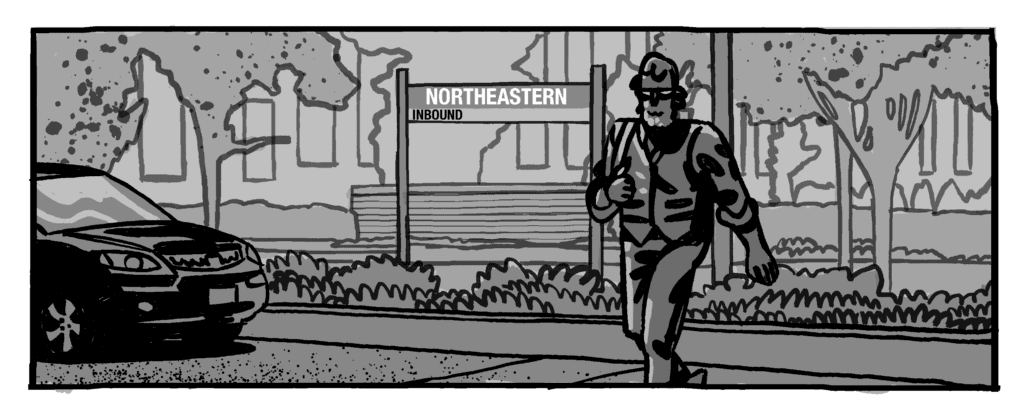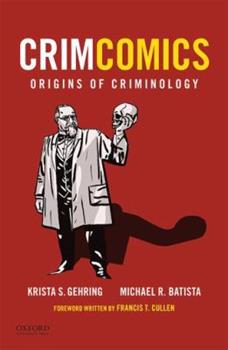For most readers, comic books are their first introduction to the criminal justice system. A supervillain commits a crime and creates chaos and puts innocent people in danger. A superhero swoops in and saves the day, restoring peace and justice (until the villain strikes again).


This, along with dramatized depictions of crime and justice in movies and television shows, piqued Dr. Krista Gehring’s interest in studying criminal justice when she began her master’s degree at Northeastern University. She was certain that she wanted to be a criminal profiler, but quickly got a reality check from Professor Jack McDevitt, who told her, “If you want to be a criminal profiler, go to Hollywood.” With his words in mind, she had to adapt quickly, and began focusing on criminal justice theories and the realities of the criminal justice system. In her classes she met and became friends with Michael Batista, another criminal justice student pursuing his master’s degree.

While at Northeastern, Krista (’03) and Michael (’03) discovered they had a mutual interest in comic books. Krista had a passion for writing and Michael loved to draw, so they combined their talents to create a variety of vampire comics. On a few occasions, Krista house-sat for Nicky Rafter, and Michael would visit and they would hammer out ideas for comics while sitting on her back porch. Together, they decided that they wanted to collaborate as much as possible on as many things as possible.
After earning her master’s degree, Krista went on to get her PhD at the University of Cincinnati. While there, she taught undergraduate students about criminological theories. Her students weren’t excited about the material at all, so Krista tried to think of ways to make the material more engaging. She thought about using more movies in her classes, but there weren’t many criminal justice movies that were directly related to theories of crime. One day in 2009, the idea of creating criminal justice comic books finally came to her, and she called up Michael and asked him what he thought of the idea. He was immediately on board, so she wrote up a script for the first issue and he drew the illustrations, just like they had in back at NEU. “I thought it was a great idea,” said Michael, “The average comic book reader is already acquainted with crime in a superhero and villain kind of way, and we just wanted to put that dynamic under a microscope in a more academic way.”
Five years later, they signed a contract with Oxford University Press to make 13 issues of CrimComics. These are educational comics created that present theories of crime in an interesting, engaging, and very real way. They are an easily digestible way to get a lot of material across in just a few pages, and really encourage the reader to make connections about what they are reading as they are reading it, which is why Krista often uses CrimComics in her own classrooms in addition to traditional textbooks. Her students read the comics before the textbook, which helps them understand the material a lot better. “Comics involve active reading,” Krista explained, “and there is an interplay between the text and images that leads to better recall and transfer of learning. It’s also a great way to convey a large amount of information in a short time.”
Krista and Michael have many ideas for the future of CrimComics after their thirteenth issue is published, but the main one is to combine all the issues into one book. “That edition, where all of the issues are combined – that will be our Watchmen,” said Krista, excitedly. “I also hope more instructors will start using them in their classrooms. It’s hard to get away from the traditional way of thinking about how information should be presented to students, but what I’ve learned is that students cannot possibly learn everything, so what I want my students to know are the “greatest hits,” the ones that are directly related to policies and programs, so I teach those through CrimComics, which is better than having them memorize some laundry list of theories that might not be applicable today.” Krista and Michael have also considered creating CrimComics trading cards or motion comics, but emphasized that the possibilities are endless, and their focus now is on finishing the remaining issues.
CrimComics can be purchased directly from Oxford University Press. To learn more, Krista recently discussed the evolution of CrimComics with Dr. Barbi Honeycutt on the Lecture Breakers podcast.
Keep up on Twitter:
CrimComics (@CrimComicsOUP)
Krista Gehring (@kristasgehring)
Michael Batista (@michaelbatista)
Keep up on Instagram:
Michael Batista (@michaelbatista)
Written by criminal justice student Jazmin Sandoval ’22.




